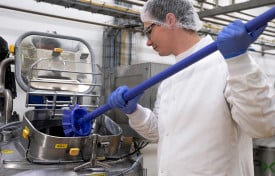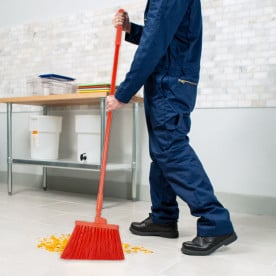food safety

- November 25, 2024
What We Learned at the Fall 2024 Dairy Sustainability Conference
Nearly 400 from the dairy industry gathered in Minneapolis last week for the 2024 Dairy Sustainability Alliance Fall Meeting. And while dairy sustainability is evergreen, the first-ever sell-out crowd proved that the topic has never been more critical than it is today.
The fall gathering featured a day filled with sessions from dairy industry experts and leaders, and the Nelson-Jameson team was in attendance to participate in the discussions that will help shape the future of dairy sustainability and solutions.
We had an incredible time at the summit where attendees learned ways to evolve their strategies along with the evolution of dairy sustainability itself. Below are
- May 22, 2023
Strategic Expansion Offers Best-In-Class Solutions For Food Processors Nationwide
Marshfield, WI, April 17, 2023 – Nelson-Jameson, Inc., a leading distributor in the food processing industry, announced the acquisition of Sitzman Supply, LLC, a wholesale provider of process systems products located in Alden, New York. The acquisition is part of a long-term expansion plan that allows Nelson-Jameson to further develop its strategic relationships and offer additional technical sales coverage in the Eastern region.
Mike Rindy, Nelson-Jameson’s President, stated, “Nelson-Jameson is pleased to welcome Sitzman Supply to the family as a part of our national expansion. The synergies will allow us to better serve our customers, and the geographic growth demonstrates our commitment to the Eastern region. This expansion strengthens Nelson-Jameson's position as an industry leader that delivers supplies
- April 10, 2022
Nelson-Jameson is a proud member of the Innovation Center for US Dairy. The Center and its members have a common goal “to advance a shared social responsibility platform and demonstrate U.S. dairy’s collective commitment to provide the world responsibly produced dairy foods that nourish people, strengthen communities and foster a sustainable future.”
Nelson-Jameson and the Center have a combined passion for furthering food safety in our nation. Recently, the Center published a terrific food safety resource for the dairy industry that includes numerous Spanish language materials. Resources to take advantage of include: interactive training courses for artisan ice cream and cheesemakers, food safety plan writing assistance, training support, pathogen guidance documents, and much
- November 07, 2021
For many people throughout the United States, hunting wild game is a beloved pastime--whether for the enjoyment of the outdoors, thrill of the hunt, or an economical way to obtain food. Along with this hobby comes many safety precautions. Just as a hunter should be trained in firearm safety and first aid procedures, food safety is also important. Educating one’s self on the dangers of foodborne illness is one step closer to harvesting a game animal for safe consumption.
Know The Risks
Harmful bacteria such as Salmonella and E.coli can live in raw or undercooked game meats. It is important to note the stages in which contamination may occur, and what steps can be taken to ensure you have processed your animal in the safest means possible.Contamination can occur through the initial wound sustained by a bullet or an arrow. It is best to avoid hitting or puncturing the area around the stomach and intestines, as this would result in spoiling much of
- June 23, 2020
A critical component in food safety is the detection of contaminants. One of the worst nightmares of anyone working in food processing, is finding something in the final product that is not supposed to be there. This can cause costly product loss, clean-up and maintenance costs, and the potential for recalls and/or litigation. Even though everyone tries to prevent foreign object contamination, pieces of tools such as scrapers can break off, or items such as pens can fall into the product. To make sure that these items are caught, and that contaminated product does not make it out the door, many plants utilize metal detection devices and products.
Metal detectable products are constructed of a few different materials. They are often blue for easy visual detection. Blue is also the most common non-food color.
- September 10, 2019
At Nelson-Jameson, we never take chances when it comes to food safety, and neither should you. That's why we've put together a comprehensive flyer that is filled with the products you need to create an effective food safety program in your plant. Even more promising than the quality products is the manufacturers that are represented—we’ve included top products from 3M™, Hygiena™, Nasco, and Neogen®. Let us help you implement the Environmental Testing Solutions that work for your plant.
- August 29, 2019
The need to be seen is critical for employee safety, especially for those who work around moving vehicles and equipment. This is why we have a wide range of high-visibility apparel that meets the ANSI/ISEA 107-2015 Standard.
Take a look at our high-visibility products here!
The ANSI/ISEA 107-2015 standard provides a uniform, authoritative guide for the design, performance specifications, and use of high-visibility and reflective apparel, including safety vests, shirts, pants, and outerwear. The standard breaks down high-visibility apparel into Types
- May 01, 2019
Nelson-Jameson has expanded their color-coded program once again with the release of their 2019 Color-Coded Catalog. This year's catalog has grown to 56 pages of products that help to prevent allergen migration and cross-contamination. From the lab to the processing line, Nelson-Jameson has the color-coded products you need to produce safe, quality food.
In addition to having the most extensive color-coded program in the industry, we also have the most color options! Nelson-Jameson is now proud to offer gray, brown and lime products from Remco/Vikan® to help meet all your color-coded needs. The expanded catalog also includes new items like Color-Coded Cable Ties, Flagged Angle Brooms, Nylon Scrapers and more!
- July 30, 2018
In recent months, it has come to our attention that there has been an increase in quality problems caused by Heterofermentative lactic bacteria that are not from starter cultures. These bacteria have been found growing on biofilms in the pasteurizer regen section of milk HTST’s, in some silage inoculants, in dairy powders and liquids used to fortify milk for cheesemaking, and on individual farms with certain cleaning issues. Once these are in the milk, they can’t be removed by pasteurization and will carry through into the cheese and whey powder by-products.
The Center for Dairy Research (CDR) in Madison has seen an increase in quality defects in cheese including off flavors such as “sour” gas formation in retail packages of cheese and cracking defects in blocks of cheese. Many companies are starting to include specifications for low spore count non-fat powders, liquid condensed skim and UF milk products, and also whey powders used in many other foods.
- March 22, 2018
In the demanding everyday life of a food manufacturer it can be hard to slow down and think about the safety of the products being manufactured. Everything from the ingredients that come in the door to the way the product is shipped out to the customer, all have to be monitored for safety. That is what the Food Safety Modernization Act (FSMA) is all about, making sure the ingredients, the process, and how the end product is shipped out reduces the level of risk to the consumer. The manufacturing facility has to ask, what can be done to prevent the various risks in the plant from happening and causing a recall?
A Food Safety Plan is a robust, detailed plan that is meant to anticipate and meet these challenges. A cohesive plan is based on food safety principles which include: hazard analysis, preventative controls, supply-chain programs, and a recall plan. For smaller businesses, putting a Food Safety Plan in place and maintaining that Plan can be daunting. Where do you start? Making







